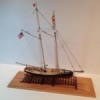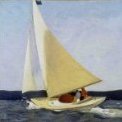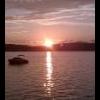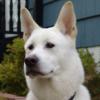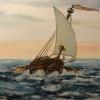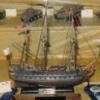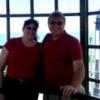-
Posts
815 -
Joined
-
Last visited
Reputation Activity
-
 _SalD_ got a reaction from BETAQDAVE in Phantom by _SalD_ - FINISHED - 1/8" scale
_SalD_ got a reaction from BETAQDAVE in Phantom by _SalD_ - FINISHED - 1/8" scale
Max, the font is called 'unicorn' on my software. I had thought about using a little wood filler to feather the edges but I didn't want to take the chance of screwing it up. If I take my reading glasses off it looks perfect anyway. Does the vellum have a shiny finish? Because I tried printing it on a sheet of (showing my age) overhead projector transparency film and it was very noticeable on the ship. As far as deterioration, I have a few years on you so I don't think I need to worry about the paper deterioration as much as my own.
-
 _SalD_ got a reaction from Jay 1 in Phantom by _SalD_ - FINISHED - 1/8" scale
_SalD_ got a reaction from Jay 1 in Phantom by _SalD_ - FINISHED - 1/8" scale
Completed the fore deck fixtures.
I assembled the fore deck companionway, painted the vent pipe and made the wire guard, painted the anchor, made two more bollards, made the davit from the wire of a paper clip, installed handles (used 28 gage wire) on the winch bits and then painted it, and made another mast coat for the fore mast similar to the one made for the main mast.
The positions of all these pieces were located on the fore deck from the plans and the appropriate size holes were drilled in the deck. All the parts were then glued in place. Note that there is another eye bolt that appears to be needed near the fore fife rail that is not mentioned in the practicum until later in the rigging chapters.
According to the Chuck’s practicum I am now officially half way complete with my ship.
I must admit I do feel a sense of accomplished in the progress I've made to this point. I've enjoyed each task preformed so far, although some less than others. Coppering the hull is pretty far down on the list. I would also like to take this time to thank Mr. Chuck Passaro for his excellent practicum. If it wasn't for his guidance through his practicum I would have never been able to complete all this. It’s always easier to enhance things that someone has already designed. I hope that the second half of this build goes as well (knock on wood) as the first. With Chuck’s guide I’m sure it will. Since I’m thanking people; I would like to thank everyone for their words of encouragement and help and for all the ‘likes’ so far.
-
 _SalD_ got a reaction from yvesvidal in Phantom by _SalD_ - FINISHED - 1/8" scale
_SalD_ got a reaction from yvesvidal in Phantom by _SalD_ - FINISHED - 1/8" scale
Completed the fore deck fixtures.
I assembled the fore deck companionway, painted the vent pipe and made the wire guard, painted the anchor, made two more bollards, made the davit from the wire of a paper clip, installed handles (used 28 gage wire) on the winch bits and then painted it, and made another mast coat for the fore mast similar to the one made for the main mast.
The positions of all these pieces were located on the fore deck from the plans and the appropriate size holes were drilled in the deck. All the parts were then glued in place. Note that there is another eye bolt that appears to be needed near the fore fife rail that is not mentioned in the practicum until later in the rigging chapters.
According to the Chuck’s practicum I am now officially half way complete with my ship.
I must admit I do feel a sense of accomplished in the progress I've made to this point. I've enjoyed each task preformed so far, although some less than others. Coppering the hull is pretty far down on the list. I would also like to take this time to thank Mr. Chuck Passaro for his excellent practicum. If it wasn't for his guidance through his practicum I would have never been able to complete all this. It’s always easier to enhance things that someone has already designed. I hope that the second half of this build goes as well (knock on wood) as the first. With Chuck’s guide I’m sure it will. Since I’m thanking people; I would like to thank everyone for their words of encouragement and help and for all the ‘likes’ so far.
-
 _SalD_ got a reaction from yvesvidal in Phantom by _SalD_ - FINISHED - 1/8" scale
_SalD_ got a reaction from yvesvidal in Phantom by _SalD_ - FINISHED - 1/8" scale
I thought that after building the companion way and skylight, the fife rail would be a piece of cake. Clean up the castings, slap a few coats of paint on it and glue it to the deck. Wrong! Now you need to make a tiny cleat. I wasn't quite sure what to make the cleat out of so I tried a piece of the 1/32” thick sheet. That didn't work too well because the piece broke apart too easily. I ended up using a piece of the 1/8” square stock. I drew the profile of the cleat on the side of the wood and started filing. Using needle files and an emery board I whittled away until all I had left was the cleat. Sort of like making a toothpick from a 12” diameter log. I decided to do both fife rails at the same time so I make two cleats.
Assembling the fife rail was simple enough; the two stanchions were glued on, painted it white, installed the belaying pins, that I had previously blackened, and glued on the cleat. The one modification I made was to remove the pins on the bottom of the stanchions that are supposed to be fastened into the deck. I thought that the large pins on the other two legs of the rail would be sufficient to hold it in place and that drilling two holes in the deck would be easier to position than four.
The pumps were painted black and the navigation light stands were made just as described in Chuck’s practicum. My jumbo paper clips seemed a bit thick so I used a ‘Size 1’ paper clip. The lights in the picture are not finished and still need another coat of paint and have the handle attached.
The mast coat, I discovered, could easily be made using my three-hole punch. I punched out some holes of the manila folder, used my circle template to draw the inner hole for the mast and cut it out with my x-acto knife.
Once all the parts were ready; first the mast coat was glued to the deck using the mast dowel to get its correct position. Then I glued the fife rail into the holes that I had previously drilled when I installed the skylight. The holes for the pumps were drilled a bit off from where they show on the plans, in a position that looked good and was easy to drill. The last thing I installed was an eye bolt on the starboard side of the fife rail. This eye bolt is shown on the drawings and is mentioned in the practicum later on when Chuck describes rigging the Main Gaff.
-
 _SalD_ got a reaction from usedtosail in Phantom by _SalD_ - FINISHED - 1/8" scale
_SalD_ got a reaction from usedtosail in Phantom by _SalD_ - FINISHED - 1/8" scale
Completed the fore deck fixtures.
I assembled the fore deck companionway, painted the vent pipe and made the wire guard, painted the anchor, made two more bollards, made the davit from the wire of a paper clip, installed handles (used 28 gage wire) on the winch bits and then painted it, and made another mast coat for the fore mast similar to the one made for the main mast.
The positions of all these pieces were located on the fore deck from the plans and the appropriate size holes were drilled in the deck. All the parts were then glued in place. Note that there is another eye bolt that appears to be needed near the fore fife rail that is not mentioned in the practicum until later in the rigging chapters.
According to the Chuck’s practicum I am now officially half way complete with my ship.
I must admit I do feel a sense of accomplished in the progress I've made to this point. I've enjoyed each task preformed so far, although some less than others. Coppering the hull is pretty far down on the list. I would also like to take this time to thank Mr. Chuck Passaro for his excellent practicum. If it wasn't for his guidance through his practicum I would have never been able to complete all this. It’s always easier to enhance things that someone has already designed. I hope that the second half of this build goes as well (knock on wood) as the first. With Chuck’s guide I’m sure it will. Since I’m thanking people; I would like to thank everyone for their words of encouragement and help and for all the ‘likes’ so far.
-
 _SalD_ got a reaction from mspringer in Phantom by _SalD_ - FINISHED - 1/8" scale
_SalD_ got a reaction from mspringer in Phantom by _SalD_ - FINISHED - 1/8" scale
Completed the fore deck fixtures.
I assembled the fore deck companionway, painted the vent pipe and made the wire guard, painted the anchor, made two more bollards, made the davit from the wire of a paper clip, installed handles (used 28 gage wire) on the winch bits and then painted it, and made another mast coat for the fore mast similar to the one made for the main mast.
The positions of all these pieces were located on the fore deck from the plans and the appropriate size holes were drilled in the deck. All the parts were then glued in place. Note that there is another eye bolt that appears to be needed near the fore fife rail that is not mentioned in the practicum until later in the rigging chapters.
According to the Chuck’s practicum I am now officially half way complete with my ship.
I must admit I do feel a sense of accomplished in the progress I've made to this point. I've enjoyed each task preformed so far, although some less than others. Coppering the hull is pretty far down on the list. I would also like to take this time to thank Mr. Chuck Passaro for his excellent practicum. If it wasn't for his guidance through his practicum I would have never been able to complete all this. It’s always easier to enhance things that someone has already designed. I hope that the second half of this build goes as well (knock on wood) as the first. With Chuck’s guide I’m sure it will. Since I’m thanking people; I would like to thank everyone for their words of encouragement and help and for all the ‘likes’ so far.
-
 _SalD_ got a reaction from Littlebob in Phantom by _SalD_ - FINISHED - 1/8" scale
_SalD_ got a reaction from Littlebob in Phantom by _SalD_ - FINISHED - 1/8" scale
Completed the fore deck fixtures.
I assembled the fore deck companionway, painted the vent pipe and made the wire guard, painted the anchor, made two more bollards, made the davit from the wire of a paper clip, installed handles (used 28 gage wire) on the winch bits and then painted it, and made another mast coat for the fore mast similar to the one made for the main mast.
The positions of all these pieces were located on the fore deck from the plans and the appropriate size holes were drilled in the deck. All the parts were then glued in place. Note that there is another eye bolt that appears to be needed near the fore fife rail that is not mentioned in the practicum until later in the rigging chapters.
According to the Chuck’s practicum I am now officially half way complete with my ship.
I must admit I do feel a sense of accomplished in the progress I've made to this point. I've enjoyed each task preformed so far, although some less than others. Coppering the hull is pretty far down on the list. I would also like to take this time to thank Mr. Chuck Passaro for his excellent practicum. If it wasn't for his guidance through his practicum I would have never been able to complete all this. It’s always easier to enhance things that someone has already designed. I hope that the second half of this build goes as well (knock on wood) as the first. With Chuck’s guide I’m sure it will. Since I’m thanking people; I would like to thank everyone for their words of encouragement and help and for all the ‘likes’ so far.
-
 _SalD_ got a reaction from divarty in Phantom by _SalD_ - FINISHED - 1/8" scale
_SalD_ got a reaction from divarty in Phantom by _SalD_ - FINISHED - 1/8" scale
Completed the fore deck fixtures.
I assembled the fore deck companionway, painted the vent pipe and made the wire guard, painted the anchor, made two more bollards, made the davit from the wire of a paper clip, installed handles (used 28 gage wire) on the winch bits and then painted it, and made another mast coat for the fore mast similar to the one made for the main mast.
The positions of all these pieces were located on the fore deck from the plans and the appropriate size holes were drilled in the deck. All the parts were then glued in place. Note that there is another eye bolt that appears to be needed near the fore fife rail that is not mentioned in the practicum until later in the rigging chapters.
According to the Chuck’s practicum I am now officially half way complete with my ship.
I must admit I do feel a sense of accomplished in the progress I've made to this point. I've enjoyed each task preformed so far, although some less than others. Coppering the hull is pretty far down on the list. I would also like to take this time to thank Mr. Chuck Passaro for his excellent practicum. If it wasn't for his guidance through his practicum I would have never been able to complete all this. It’s always easier to enhance things that someone has already designed. I hope that the second half of this build goes as well (knock on wood) as the first. With Chuck’s guide I’m sure it will. Since I’m thanking people; I would like to thank everyone for their words of encouragement and help and for all the ‘likes’ so far.
-
 _SalD_ got a reaction from ScottRC in Phantom by _SalD_ - FINISHED - 1/8" scale
_SalD_ got a reaction from ScottRC in Phantom by _SalD_ - FINISHED - 1/8" scale
Completed the fore deck fixtures.
I assembled the fore deck companionway, painted the vent pipe and made the wire guard, painted the anchor, made two more bollards, made the davit from the wire of a paper clip, installed handles (used 28 gage wire) on the winch bits and then painted it, and made another mast coat for the fore mast similar to the one made for the main mast.
The positions of all these pieces were located on the fore deck from the plans and the appropriate size holes were drilled in the deck. All the parts were then glued in place. Note that there is another eye bolt that appears to be needed near the fore fife rail that is not mentioned in the practicum until later in the rigging chapters.
According to the Chuck’s practicum I am now officially half way complete with my ship.
I must admit I do feel a sense of accomplished in the progress I've made to this point. I've enjoyed each task preformed so far, although some less than others. Coppering the hull is pretty far down on the list. I would also like to take this time to thank Mr. Chuck Passaro for his excellent practicum. If it wasn't for his guidance through his practicum I would have never been able to complete all this. It’s always easier to enhance things that someone has already designed. I hope that the second half of this build goes as well (knock on wood) as the first. With Chuck’s guide I’m sure it will. Since I’m thanking people; I would like to thank everyone for their words of encouragement and help and for all the ‘likes’ so far.
-
 _SalD_ got a reaction from ScottRC in Phantom by _SalD_ - FINISHED - 1/8" scale
_SalD_ got a reaction from ScottRC in Phantom by _SalD_ - FINISHED - 1/8" scale
I thought that after building the companion way and skylight, the fife rail would be a piece of cake. Clean up the castings, slap a few coats of paint on it and glue it to the deck. Wrong! Now you need to make a tiny cleat. I wasn't quite sure what to make the cleat out of so I tried a piece of the 1/32” thick sheet. That didn't work too well because the piece broke apart too easily. I ended up using a piece of the 1/8” square stock. I drew the profile of the cleat on the side of the wood and started filing. Using needle files and an emery board I whittled away until all I had left was the cleat. Sort of like making a toothpick from a 12” diameter log. I decided to do both fife rails at the same time so I make two cleats.
Assembling the fife rail was simple enough; the two stanchions were glued on, painted it white, installed the belaying pins, that I had previously blackened, and glued on the cleat. The one modification I made was to remove the pins on the bottom of the stanchions that are supposed to be fastened into the deck. I thought that the large pins on the other two legs of the rail would be sufficient to hold it in place and that drilling two holes in the deck would be easier to position than four.
The pumps were painted black and the navigation light stands were made just as described in Chuck’s practicum. My jumbo paper clips seemed a bit thick so I used a ‘Size 1’ paper clip. The lights in the picture are not finished and still need another coat of paint and have the handle attached.
The mast coat, I discovered, could easily be made using my three-hole punch. I punched out some holes of the manila folder, used my circle template to draw the inner hole for the mast and cut it out with my x-acto knife.
Once all the parts were ready; first the mast coat was glued to the deck using the mast dowel to get its correct position. Then I glued the fife rail into the holes that I had previously drilled when I installed the skylight. The holes for the pumps were drilled a bit off from where they show on the plans, in a position that looked good and was easy to drill. The last thing I installed was an eye bolt on the starboard side of the fife rail. This eye bolt is shown on the drawings and is mentioned in the practicum later on when Chuck describes rigging the Main Gaff.
-
 _SalD_ got a reaction from ccoyle in Phantom by _SalD_ - FINISHED - 1/8" scale
_SalD_ got a reaction from ccoyle in Phantom by _SalD_ - FINISHED - 1/8" scale
Completed the fore deck fixtures.
I assembled the fore deck companionway, painted the vent pipe and made the wire guard, painted the anchor, made two more bollards, made the davit from the wire of a paper clip, installed handles (used 28 gage wire) on the winch bits and then painted it, and made another mast coat for the fore mast similar to the one made for the main mast.
The positions of all these pieces were located on the fore deck from the plans and the appropriate size holes were drilled in the deck. All the parts were then glued in place. Note that there is another eye bolt that appears to be needed near the fore fife rail that is not mentioned in the practicum until later in the rigging chapters.
According to the Chuck’s practicum I am now officially half way complete with my ship.
I must admit I do feel a sense of accomplished in the progress I've made to this point. I've enjoyed each task preformed so far, although some less than others. Coppering the hull is pretty far down on the list. I would also like to take this time to thank Mr. Chuck Passaro for his excellent practicum. If it wasn't for his guidance through his practicum I would have never been able to complete all this. It’s always easier to enhance things that someone has already designed. I hope that the second half of this build goes as well (knock on wood) as the first. With Chuck’s guide I’m sure it will. Since I’m thanking people; I would like to thank everyone for their words of encouragement and help and for all the ‘likes’ so far.
-
 _SalD_ reacted to Stockholm tar in Making rope coils
_SalD_ reacted to Stockholm tar in Making rope coils
Mkmossop,
As Mike implied most, if not all, lines will have a working length, which means the end will be coiled to a belaying pin (normally clockwise). The coils will also roughly be about the same size (although each may not have the same amount of line) and hang just clear of the deck, to prevent them picking up any wet or damp from it.
The way I make mine is to cut off a length of thread appropriate for that particular line you have in mind. You can more-or-less gauge this by thinking of the job it does on the ship, and the distance it may have to 'run', eg. for the braces, how far are the yards are likely to swing, fore and aft? This may not seem important, but will most likely be spotted by anyone who knows. (Btw, in the same way, if you were to have the yards on your model braced round, the side which has the yardarms furthest aft, would have more line on that side than the other. Similarly with halliards. If the yards, or staysails, are hoisted then there would be more rope to the coils, than if they were lowered.)
A useful way to make coils, I have found, is to use a pair of closed tapered pliers (you can keep them closed with an elastic band around the handles). Then, having gauged how large you wish to make the coil (the taper of the pliers helps here), take the amount of line you need and run it through your thumb and forefinger, which are lightly smeared with glue (I use wood glue). Beginning with one end, at an appropriate point on the pliers, slowly wrap the line around the plier nose (in a clockwise direction) so that the turns are close to one another, for the length of the line. Some care is needed to ensure the turns are even, but it doesn't matter that they overlap here and there, as it will look more realistic. The end should come down the right side of the coil, and I normally cut it off about half way down.
You should now have a coil glued to itself, but not of course the pliers! Before it is quite dry slip the coil off the nose, and press into more of an oval shape. Then when dry you will have a nice looking coil ready to glue to the rail at the pin. Any dry glue that adheres itself to the pliers can be quickly removed with a fine sandpaper.
I hope this helps.
-
 _SalD_ reacted to FlounderFillet5 in Phantom by FlounderFillet5 - Model Shipways - Pilot Boat
_SalD_ reacted to FlounderFillet5 in Phantom by FlounderFillet5 - Model Shipways - Pilot Boat
Hey all,
Robert, Russ, and Sal: Thanks for the kind words on the progress. Sal, glad you found something useful in my log, take any ideas you find here and run with them, that's why these build logs exist.
I have made some more progress and now all these small projects are finally coming together and being installed on the ship, exciting!
I made the cockpit coaming cap rail by gluing on some rough shaped boxwood and filing down to size.
I used an idea that Sal came up with in his log to line the cockpit with a strip of painted material to make it look nice and neat. I used some vellum paper painted white.
This is a picture of installing it in the cockpit. Here you can see the cockpit coaming installed with its cap rail. I had test fitted this coaming multiple times and then when I went to install it, it cracked a bit so I had to glue it, leaving another little line in the cap rail.
Then I shaped the cockpit grating with my template I used to carve the sunken cockpit.
The wheel house installed with the grating in place.
I made some make shift seizings that I am installing on all of the stropped blocks. This jig is a number drill held in a vise and the string is wrapped around several times and glued with some thin CA. I also drilled a hole through a little piece of brass that is used for breaking the glued siezing free from the drill bit shank.
The traveler I mentioned that was installed last time with siezings in place.
Here are the bollards for the deck. I made them out of some boxwood and some of the thin black wire supplied with the kit.
Here they are installed.
And last but not least, a top view of the aft deck nearly completed. I think all I have left is to install the stove pipe (being painted right now), the wire frame that will protect it, the skylight, and the navigational lights which might be put on hold a little while longer until the fore deck is also completed so that I don't accidentally knock them off repeatedly which seems like an inevitability if I install them now. Oh, I guess the fife rail also needs to be installed before the aft deck is complete.
Hope you enjoyed this update, I know I have been enjoying actually installing all these things to the ship, hard work is finally paying off!
Best Regards,
-
 _SalD_ got a reaction from KevinR in Phantom by _SalD_ - FINISHED - 1/8" scale
_SalD_ got a reaction from KevinR in Phantom by _SalD_ - FINISHED - 1/8" scale
I thought that after building the companion way and skylight, the fife rail would be a piece of cake. Clean up the castings, slap a few coats of paint on it and glue it to the deck. Wrong! Now you need to make a tiny cleat. I wasn't quite sure what to make the cleat out of so I tried a piece of the 1/32” thick sheet. That didn't work too well because the piece broke apart too easily. I ended up using a piece of the 1/8” square stock. I drew the profile of the cleat on the side of the wood and started filing. Using needle files and an emery board I whittled away until all I had left was the cleat. Sort of like making a toothpick from a 12” diameter log. I decided to do both fife rails at the same time so I make two cleats.
Assembling the fife rail was simple enough; the two stanchions were glued on, painted it white, installed the belaying pins, that I had previously blackened, and glued on the cleat. The one modification I made was to remove the pins on the bottom of the stanchions that are supposed to be fastened into the deck. I thought that the large pins on the other two legs of the rail would be sufficient to hold it in place and that drilling two holes in the deck would be easier to position than four.
The pumps were painted black and the navigation light stands were made just as described in Chuck’s practicum. My jumbo paper clips seemed a bit thick so I used a ‘Size 1’ paper clip. The lights in the picture are not finished and still need another coat of paint and have the handle attached.
The mast coat, I discovered, could easily be made using my three-hole punch. I punched out some holes of the manila folder, used my circle template to draw the inner hole for the mast and cut it out with my x-acto knife.
Once all the parts were ready; first the mast coat was glued to the deck using the mast dowel to get its correct position. Then I glued the fife rail into the holes that I had previously drilled when I installed the skylight. The holes for the pumps were drilled a bit off from where they show on the plans, in a position that looked good and was easy to drill. The last thing I installed was an eye bolt on the starboard side of the fife rail. This eye bolt is shown on the drawings and is mentioned in the practicum later on when Chuck describes rigging the Main Gaff.
-
 _SalD_ got a reaction from Stockholm tar in Anchor Question
_SalD_ got a reaction from Stockholm tar in Anchor Question
Kester,
Thanks for all the information. It makes sense now. Sometimes I'm a little slow but I usually catch on after a while.
-
 _SalD_ got a reaction from bhermann in Phantom by _SalD_ - FINISHED - 1/8" scale
_SalD_ got a reaction from bhermann in Phantom by _SalD_ - FINISHED - 1/8" scale
Well it took some time and the jury is still out whether all the time I put into building the skylight was worth it, but I finally finished it.
I took Chuck’s advice making separate window frames mounted on a small block to make up the skylight. I used 1/16” square stock for my frames, so I made the block 1/8” smaller than the dimensions of the skylight taken from the plans.
I’d like to mention here that in hind sight I should NOT have used the length dimension of the skylight from the plans. As it turned out, the skylight, using the dimension from the plans, would not have fit between the stove pipe and fife rail of the aft mast whose hole I had already drilled in the deck. Fortunately, I discovered this before I assembled all the pieces. I ended up shortening the block and sanding down the end window jambs of the three pane frame to make it fit and it’s still pretty tight.
I then decided to try and put the bars on the windows. First I drew guide lines on the frames above and below the windows. I then marked off the location of each bar along the guide lines which, for my windows ended up being 1 mm apart. I then drilled a hole at each mark and then erased the guide lines. I had already picked the wire I was going to use so I knew what size hole to make. For the bars I thought that the 28 gage wire that comes with the kit would be too thick. Since the Admiral has tightened the purse strings on buying any additional material for this build ( I can’t imagine why) I looked for something I already had. What I found, and used, was the copper wire from some 16/2 speaker wire I had used to wire the surround sound in the family room. I striped a piece of the sheathing, blackened the wire and had the material for the bars. I’m guessing the individual strands are around 30 gage.
My next problem was to find something that I could make the bars with so that they would be all same size. After trying a few methods that didn’t work too well, what I stumbled upon was to use my needle nose pliers. As can be seen in the photo below, I placed a pencil mark at the position along one of the jaws that equaled the length of bar I needed. I then clamped the wire in the jaws and bent the wire down to form a square ‘U’ shape. I then trimmed the wire as required and inserted the ends into the holes. Trying to impress my daughter, I showed her what I was doing and unimpressed she told me that I have way too much time on my hands (next life, no kids ). I installed all the bars prior to gluing them in. Before gluing them I threaded one of the unblackened wires between the window frame and bars so as to keep them slightly off the frame.
After all that, I assembled the skylight gluing the frames to the small block. Before gluing the frames on however I placed a piece of transparent tape around the block as in the practicum.
For the roof I tried a different procedure than I used for the wheelhouse and cockpit companionway. For those two items I installed the roof pieces directly on the block one at a time, for the skylight I tried making the roof independently and then installing it in one piece. I pre-bent the edge pieces first by soaking them and taping them to an ice bucket with the appropriate radius. I then installed the roof members in between them, gluing them in place as I went. Once the entire roof was made I glued it on to the skylight. To finish I installed the base board trim around the bottom.
Was it worth putting the bars on? I think so. It took a while but in the end I think it was worth the effort. Maybe I should have made them a little smaller. The fife rail is only in temporarily to make sure it all fit.
-
 _SalD_ got a reaction from piperjoe in Phantom by _SalD_ - FINISHED - 1/8" scale
_SalD_ got a reaction from piperjoe in Phantom by _SalD_ - FINISHED - 1/8" scale
Cut in the scuppers and added the timberheads along the bulwarks.
I drilled the scupper slots as described in the practicum and filed the openings smooth. One thing in hindsight that I should have done differently is not to have installed the waterway until after cutting in the scuppers. I would have set the waterway in place to get the correct location of the scuppers but then removed it so as not to damage it while drilling the scuppers. I used the manila folder paper as described in Chuck’s practicum for the waterway.
The timberheads went in easily. Cut them all a little long and then sanded them down to the height of the bulwarks. I also pre-painted the wood to keep down the number of coats I would need to give them in place. One thing about the bulwarks though, they seem to keep growing. I thought I had sanded them down pretty thin but every time I look at them they get thicker and thicker. Have to stop looking.
-
 _SalD_ got a reaction from piperjoe in Phantom by _SalD_ - FINISHED - 1/8" scale
_SalD_ got a reaction from piperjoe in Phantom by _SalD_ - FINISHED - 1/8" scale
Finished the Launching Ways. Took a few liberties with the ground way support stacks. I extended the bottom timbers and added an additional timber at the top. As a structural engineer it appeared that they needed to distribute the load more and to keep the ground way rails from moving laterally. Hope that's not against the rules.
I guess I have no more excuses now, I'll have to start coppering the hull.
-
 _SalD_ got a reaction from piperjoe in Phantom by _SalD_ - FINISHED - 1/8" scale
_SalD_ got a reaction from piperjoe in Phantom by _SalD_ - FINISHED - 1/8" scale
Day 4: Started carving from station 5 to stern. Actually starting to enjoy this. Need to remember to keep chisel sharpened.
Finished rough craving and sanded hull. Came out better than expected. Have one dent but nothing real noticeable, may try filler to even it out.
-
 _SalD_ reacted to FlounderFillet5 in Phantom by _SalD_ - FINISHED - 1/8" scale
_SalD_ reacted to FlounderFillet5 in Phantom by _SalD_ - FINISHED - 1/8" scale
Sal,
I just stumbled upon your build and am very impressed! I am at roughly the same point in my Phantom build, a little bit behind where you are currently. I am going to be installing the cockpit coamings and whatnot very soon and your idea for putting painted manila folder on the inside is absolute genius! I may just have to steal that feature for my build. Thank you for helping find a solution to something that has been bothering me about my build and I look forward to your progress.
Happy building,
-
 _SalD_ reacted to FlounderFillet5 in Phantom by FlounderFillet5 - Model Shipways - Pilot Boat
_SalD_ reacted to FlounderFillet5 in Phantom by FlounderFillet5 - Model Shipways - Pilot Boat
Russ and Nils, thanks for the encouragement and stopping by.
I threaded the rigging lines through the holes in the cap rail to test the fit of the chain plates and was kind of disappointed. The rear chain plates came very close to the hull sheathing and all of the chain plates had the thin part very exposed which I figured out was wrong when I looked at the pictures of Chuck's install chain plates. Here is a picture of one of the rear chain plates.
I remade the chain plates following the process outlined in DrWatson's build log, thanks Sal for the great example to follow. These new chain plates came out MUCH better than the first set.
Then I chemically blackened the chain plates and am really happy with the results.
I think I am going to hold off on installing the chain plates until later in the build when the masts are up and I begin rigging so that I can get the proper angle on the chain plates. Next, I think I am going to install the belaying pins and eye bolts on the cap rail and then get started on installing deck furniture. I also need to wipe down the deck with some wipe on poly (this should have been done earlier in the build but it got overlooked) and paint the cleats black (this should have also been done before installation but I think we can get it done without too much of a mess.
Hope you guys enjoyed this update!
-
 _SalD_ got a reaction from Aussie048 in Phantom by _SalD_ - FINISHED - 1/8" scale
_SalD_ got a reaction from Aussie048 in Phantom by _SalD_ - FINISHED - 1/8" scale
I've completed all the pieces and installed the wheel house, cockpit coaming, companionway and the stove pipe.
The coaming pieces were a bit out of shape and needed to be bent to the shape shown on the plans. While doing the wheel house I noticed that the length of the shaft on the ship’s wheel was not very long and thought I might have a problem installing it over the coaming. To give the wheel more clearance I filed down the two coaming pieces to form a notch where the wheel house is located. I also decided to install a baseboard around the base of the coaming that matched the wheel house and companionway. Before installing the baseboard I filed down the metal rigid along the base of the coaming. I pre-bent and stained the wood strips before gluing them in place.
I actually forgot the two bollards with the cleats were provided with the kit and didn’t remember until after I had started to make them (senior moment). I liked the the ones I started so I decided not to use the ones provided. I made them from the 1/16” square wood strip, cut to the length taken from the plans. For the cleats I notched the bollard and inserted a small piece of wood.
I decided to use the grating that is provided although it’s rather large for this scale. The only modification I made was to sand it down so it wasn't so thick. I glued the pieces together prior to sanding it and then cut it to shape.
The wooden seat on top of the coaming was made from a piece of the 1/32” thick wooden sheet. Before cutting the seat out I sanded the piece down to about 1/64” so the seat wouldn't be so thick. I also notched this piece at the wheel house to match the coaming.
For the inside of the cockpit I used a piece of manila folder painted white.
After all the pieces were made I finally got to put it all together. I had to keep telling myself to be patience and let everything dry before starting. Even so I think the ploy on the grating was still a little tacky when I glued it down. I'm glad I notched the coaming and seat because the wheel never would have fit if I didn't.
The stove pipe was painted black and the guard was made out of the 28 gage black wire. Took the pipes location from the plans a drilled all the appropriate holes for it and the guard.
-
 _SalD_ got a reaction from Aussie048 in Phantom by _SalD_ - FINISHED - 1/8" scale
_SalD_ got a reaction from Aussie048 in Phantom by _SalD_ - FINISHED - 1/8" scale
Here’s my interpretation of the cockpit companionway. I cut a 1” long piece of ¼” x ½” stock for the main body and sanded it down to the sloped shape. For the roof and sliding top I used more of the dimensional lumber. I installed the curved edge strips first and then placed the roof slats in between them. The rails for the sliding top were made from two pieces of lumber glued into an 'L' shape. I finished it off with the base board trim pieces. The only thing I need to add is the hasp lock.
-
 _SalD_ got a reaction from Aussie048 in Phantom by _SalD_ - FINISHED - 1/8" scale
_SalD_ got a reaction from Aussie048 in Phantom by _SalD_ - FINISHED - 1/8" scale
I reopened the shipyard this past weekend and started to work on the deck fixtures. Made the wheel house from the ¼”x ½” stock and cut it to dimensions taken from the plans. I then sanded the top to the appropriate slope and radius. After painting the piece white I used some of my scale lumber for the roof and baseboard trim. The lumber was stained prior to gluing it to the wheel house. Finally, I drilled the hole for the ship’s wheel that will be painted and installed later.
The wheel house was only placed on the deck; I want to complete the cockpit coaming and companionway before gluing them all in place.
-
 _SalD_ got a reaction from Aussie048 in Phantom by _SalD_ - FINISHED - 1/8" scale
_SalD_ got a reaction from Aussie048 in Phantom by _SalD_ - FINISHED - 1/8" scale
Chainplates were installed following Chuck's practicum. One thing I found easier to do was to pull the thread that is hooked onto the chainplate through the hole in the caprail from the top down and then hook on the chainplate and pull the thread and chainplate back up into the hole. I used a pin that I bent the tip on to push up through the hole in the caprail and then catch it on the tread to pull it down through the hole. I then drilled the holes in the hull for the nails to secure the chainplates. Tying the deadeyes to the chainplates was an experience.
Next I located and drilled the holes in the caprail for the belaying pins and eye bolts and glued them in place. All the belaying pins, eye bolts and chainplates were blackened prior to installation. I decided to keep all the deadeyes and blocks their natural color.
I also made an installed the traveler. I pretty much followed the practicum except that I soldered the legs to the top of the traveler.
This will be my last post on my build for the next two weeks. The shipyard will be shutdown while the admiral and I go for a little R&R in the sunshine state.


